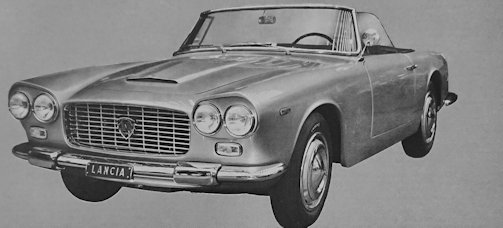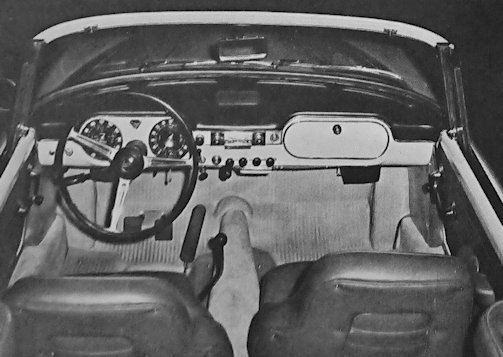Lancia Flaminia 2.8 GT Convertible
 |
|
|
Manufacturer |
Lancia Turin, Italy |
|
Production |
1963 to 1965 |
|
Class |
Sports car |
|
Body |
Convertible |
|
Layout |
Front engine, rear drive |
|
Engine |
Six Cylinder 2.8L |
|
Max Speed |
119.9 mph, 193 km |
|
Transmission |
Four-speed manual |
|
wheel base |
99.21 in, 2520 mm |
|
overall length |
177.17 in, 4500 mm |
|
overall width |
65.35 in, 1660 mm |
|
overall height |
51.18 in, 1,300 mm |
The Lancia Flaminia 3C GT Convertible 2.8 litre is an Italian sports car built in the 1960s.
History
First presented at the XVI Frankfurt Motor Show in autumn 1963, the rear wheel drive Convertible the engine size was now increased from 2.5 to 2.8 litres this was by reboring the light alloy block cylinders from 80 to 85 mm and now a sportier 150 hp at 5,400 rpm (against the previous 140hp) the maximum torque also rises from 20.7 to 22.8 mkg at 3500 rpm,165 1b ft, 22.8 kg m at 3,500 rpm giving the Flaminia 3C GT Convertible above all a significant improvement.
Technically, the Convertible undergoes the same changes affecting the Coupé, namely increased capacity of the lubrication circuit, new transmission ratios 1st 2.80, 2nd 1.86, 3rd 1.28, 4th 1 (gearbox), and axle ratio 3.538. increased diameter of the brake discs (front diameter 11.61 in, 295 mm, rear 12.09 in, 307 mm), battery with higher 45 Ah amperage and new spark plugs type. The bodywork does not undergo any changes, so much so that the new 2800 differs from its younger sister only in the addition of the specific "2.8" on the boot lid.The bodywork "Superleggera" type patented by the Touring bodywork, with aluminum panels fixed on a light steel base structure split front seats (with adjustable backrest angle) in the so-called "cloverleaf" shape and folding to facilitate access to the rear compartment (without seats).windscreen washer nozzle, light switch and turn signal activation lever, warning light and turn signal warning lights, windscreen wiper, ashtray, cigarette lighter, lockable storage compartment, fan, passenger compartment lighting, instrument lighting (dimmable), ignition position lights and projectors, service activation key. two levers for control and adjustment of left side ventilation and heating, lever for locking the bonnet, parking brake lever, reset partial odometer, clock adjustment, starter, lever for activation of heater, levers for control and adjustment of side ventilation and heating right, speed change control. Fitted with 57 litres, fuel tank of which about 7 are reserve; level gauge on the instrument panel of the dashboard.

It should be noted that the Flaminia 3C GT Convertible 2.8, which was produced only until 1964, was still available until late October 1968, the 2.8 versions, which appeared in the price lists starting from October 1963, cost 200,000 Lire more than the 2.5, or 3,635,000 (which dropped to 3,535,000 in June 1964). Evidently to dispose of the units produced but not immediately sold at the time after which it disappears permanently.
Engine type: 6-cylinder V (60°) type "826.100”; block, aluminium cylinder body with planted cast iron liners; aluminium alloy pistons, with three rings (two sealing rings and one scraper ring); aluminium cylinder head with inserted valve seats; steel connecting rods with bronze piston pin bushings; crankshaft rotating on 4 supports; suspension of the engine unit on 4 supports, on double rubber buffers. Compression ratio : 9.00:1: camshaft, in the crankcase, in a central position (i.e. placed in the angle formed by the two rows of cylinders) controlled by chain with automatic hydraulic tensioner; overhead valves (two per cylinder) inclined to each other, operated by push rods and rocker arms; hemispherical chambers; distribution timing: a) intake: opening 22° before TDC (Top Dead Centre), closing 60° (66º according to some sources) after BDC (Bottom Dead Centre): b) exhaust: opening 60° (66º according to some sources) before PMI, closing: 22° after TDC with valve clearance, special for control, mm 0.4; normal valve clearance with cold engine: intake 0.20 mm, exhaust 0.30 mm. The water ,cooling forced circulation, with centrifugal pump coaxial with the auxiliary 4-blade fan, driven by a V-belt; the system is regulated by two thermostats, one on the pipes and the other which controls the shutter to the radiator; circuit capacity (radiator and engine) litres 10 (including 1 litre of heaters); introduction of water by opening the cap on the radiator; water discharge through the tap located on the right side of the engine
Ignition: distributor; Marelli coil BZR201A; Marelli S 82 B ignition distributor; fixed advance 6°, automatic advance 11°30' more than the fixed advance; firing order: 1-4-3-6-5-2; cylinder numbering: left 1-3-5, right 2-4-6, starting from the fan; Lodge candles 2 HL; distributor contact opening mm 0.37-0.43
1 Weber 35 DCNL 3 double body inverted carburettor with choke and 2 Weber 35 DCLN 2 double body inverted carburettors without choke; Bendix-type electric pump located on the left side of the luggage compartment; adjustment data: diffuser 30 mm, main jet 1.30 mm, idle jet 0.55, air brake 2.40 mm; air filter on the carburettor, with filter element (oil bath filter on request); fuel tank located at the rear, under the luggage compartment.
Power: 150 HP at 5,400 rpm measured with the CUNA system (very similar to the SAE system, which also involved testing the engine not installed in the car, on the bench, without muffler, fan and filter). The maximum permissible engine speed is 5600 rpm / Torque: 22.8 mkg at 3500 rpm
- PERFORMANCE
- Engine capacity: 169.33 cu in, 2,775 cu cm
- Fuel consumption: 19.9 m/imp gal, 16.6 ml US gal, 14.2 1 x 100 km
- Max speed: 119.9 mph, 193 km
- Max power (CUNA): 150 hp at 5,400 rpm
- Max torque (CUNA): 165 1b ft, 22.8 kg m at 3,500 rpm
- Max number of engine rpm: 5,600
- Power-weight ratio: 19.8 lb/hp, 9 kg/hp
- Specific power: 54 hp/l
- Max speeds: 43.5 mph, 70 km/h in 1st gear; 65.2 mph, 105 km/h in 2nd gear; 94.4 mph, 152 km/h in 3rd gear; 119.9 mph, 193 km/h in 4th gear
Gearbox: 4-speed differential + reverse; all forward gears are silent and synchronized; ratios: I=2.80:1; II=1.86:1; III=1.28:1; IV=1:1; MRI=3.03:1; central control lever, power unit oil capacity (gearbox-differential) litres 4.10 (equal to kg 3.70)
Suspension Distribution of weight was 46.8% to front axle, and 53.2% to rear axle the front independent wheels with transverse quadrilateral, coil springs and stabilizer bar; double effect telescopic hydraulic shock absorbers / rear: with semi-independent wheels (De Dion scheme), via axle with transversal reaction bar and stabilizer bar, longitudinal leaf springs and double effect telescopic hydraulic shock absorbers
Steering Globe screw and roller; steering box oil capacity 0.31 litres (0.28 kg); oil introduction through the plug on the box cover (the level is normal when the oil covers the globe screw); ball joints (lubricated only during assembly); pressure greaser on the return pin; wheelhouse with telescopic hydraulic shock absorber; the driving position is on the left (right-hand drive, on request); steering wheel can be moved 40 mm forwards or backwards, with locking sleeve; steering wheel turns for full turn: 4 and 1/2.
Brakes Front: Dunlop discs / rear: Dunlop discs, with vacuum booster and independent front and rear wheel circuits, disc diameter 29.5 cm at the front and 30.7 cm at the rear; mechanical parking brake acting on the rear (the handle of the handbrake control is positioned under the dashboard); the front brakes are normally mounted on the wheels, the rear ones are mounted at the output of the clutch-gearbox-differential unit
- Models: type 826.134, 2-door, 2-seater convertible, LHD and type 824.135, 2-door, 2-seater convertible, RHD
- numbering: type 826.134/826.135: from 1001 to 1180
- Units produced: 180 (of which 176 are left-hand drive and only 4 are right-hand drive)
Technical
-
Lancia Flaminia 3C GT Convertible 2.8 Technical details and specifications (1963-1965)
ENGINE
front, 4 stroke
cylinders: 6, Vee-slanted at 60°
bore and stroke: 3.35 x 3.21 in, 85 x 81.5 mm
engine capacity: 169.33 cu in, 2,775 cu cm
compression ratio:9
cylinder block: light alloy, wet liners
cylinder head : light alloy, hemispherical combustion chambers
crankshaft bearings: 4
valves: 2 per cylinder, overhead, Vee-slanted,push-rods and rockers
camshafts: 1, at centre of Vee
lubrication: gear pump,full flow filter
carburation: 3 Weber 35 DCNL 2 and 35 DCNL 3 downdraught twin barrel carburettors
fuel feed: electric pump
cooling system: waterTRANSMISSION
driving wheels: rear
clutch: Fichtel Sachs single dry plate
gearbox: mechanical, rear; gears: 4 + reverse
synchromesh gears: all
gearbox ratios: I 2.80, II 1.86, III 1.28, IV 1, rev 3.03
gear lever: central
final drive:hypoid bevel
axle ratio: 3.538.CHASSIS
integral
front suspension: independent, wishbones, coil springs,anti-roll bar, telescopic dampers
rear suspension: de Dion rigid axle, transverse linkage bar, semi-elliptic leafsprings, anti-roll bar, telescopic dampers.STEERING
worm and roller
turns of steering wheel lock to lock: 4.25, adjustable
turning circle (between walls): 36.1 ftBRAKES
Dunlop disc (front diameter 11.61 in, 295 mm, rear 12.09 in, 307 mm)
vacuum servo
lining area: total 31.88 sq in, 205.60 sq cm.ELECTRICAL EQUIPMENT
voltage: 12 V
battery: 45 Ah
dynamo: 300 W
ignition distributor: Marelli
headlamps: 4.DIMENSIONS AND WEIGHT
wheel base: 99.21 in, 2,520 mm
front track: 53.86 in, 1,368 mm
rear track: 53.94 in, 1,370 mm
overall length: 177.16 in, 4,500 mm
overall width: 65.35 in, 1,660 mm
overall height: 51.18 in, 1,300 mm
ground clearance: 4.33 in, 110 mm
dry weight: 2,977 1b, 1,350 kg
distribution of weight (max load):46.8% front axle, 53.2% rear axle© Motor car History
Service
-
Lancia Flaminia 3C GT Convertible 2.8 Service Guide (1963-1965)
fuel: 92 oct petrol
engine oil: 10.56 imp pt, 12.68 US pt, 6 1, SAE 10W-20 (winter) 20W-30 (summer), change every 2,500 miles,4,000 km
total lubricating system capacity: 11.62 imp pt, 13.95 US pt
gearbox and final drive oil: 7.22 imp pt, 8.67 US pt, 4.1 1, SAE 90, changeevery 7,500 miles, 12,000 km
cooling system capacity: 17.60 imp pt, 21.14 US pt
steering box oil: 0.53 imp pt, 0.63 US pt. 0.3 1, SAE 90
greasing: every 2,500 miles, 4,000 km, 17 points
tappet clearances: inlet 0.008 in, 0.20 mm, exhaust 0.012 in, 0.30 mm
valve timing:inlet opens 22° before tdc and closes 60° after bdc, exhaust opens 60° before bdc and closes 22° after tdc
tyre pressure (medium load): front 27 psi, 1.9 atm, rear 30 psi, 2.1 atm.
tyres:165 x 400
fuel tank capacity: 12.8 imp gal, 15.3 US gal
carrying capacity: 353 1b, 160 kg© Motor car History
